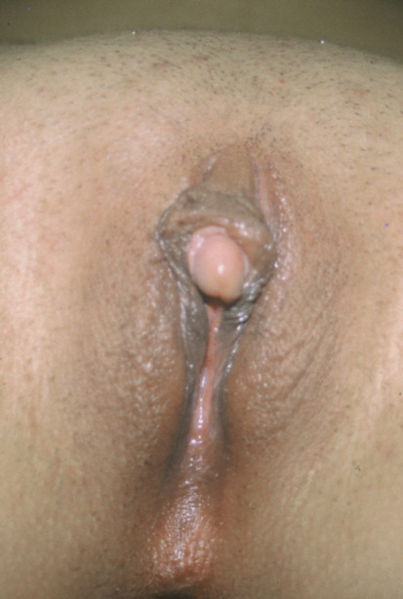Clitoromegaly
| Clitoromegaly | |
 | |
|---|---|
| Clitoromegaly | |
| ICD-10 | Q52.6 |
| ICD-9 | 752.49 |
| DiseasesDB | 30822 |
|
WikiDoc Resources for Clitoromegaly |
|
Articles |
|---|
|
Most recent articles on Clitoromegaly Most cited articles on Clitoromegaly |
|
Media |
|
Powerpoint slides on Clitoromegaly |
|
Evidence Based Medicine |
|
Clinical Trials |
|
Ongoing Trials on Clitoromegaly at Clinical Trials.gov Trial results on Clitoromegaly Clinical Trials on Clitoromegaly at Google
|
|
Guidelines / Policies / Govt |
|
US National Guidelines Clearinghouse on Clitoromegaly NICE Guidance on Clitoromegaly
|
|
Books |
|
News |
|
Commentary |
|
Definitions |
|
Patient Resources / Community |
|
Patient resources on Clitoromegaly Discussion groups on Clitoromegaly Patient Handouts on Clitoromegaly Directions to Hospitals Treating Clitoromegaly Risk calculators and risk factors for Clitoromegaly
|
|
Healthcare Provider Resources |
|
Causes & Risk Factors for Clitoromegaly |
|
Continuing Medical Education (CME) |
|
International |
|
|
|
Business |
|
Experimental / Informatics |
Editor-In-Chief: C. Michael Gibson, M.S., M.D. [2]
Overview
Clitoromegaly (or macroclitoris [1]) is an abnormal enlargement of the clitoris (not to be confused with the normal enlargement of the clitoris seen during sexual arousal).
Although clitoromegaly denotes just a clitoris larger than expected (thus involving some uncertainty about what can be defined as normal), it is commonly seen as a congenital anomaly of the genitalia.
Pathophysiology
Gross Pathology
In Atlas of Human Sex Anatomy (1949) by Dr. Robert Latou Dickinson, the normal clitoris is defined as having a crosswise width of 3 to 4 mm. (0.12 - 0.16 inches) and a lengthwise width of 4 to 5 mm (0.16 - 0.20 inches). On the other hand, in Obstetrics and Gynecology medical literature, a frequent definition of clitoromegaly is when there is a CI of greater than 35 mm2 (0.05 inches2), which is almost twice the size given above for an average sized clitoral hood [3].
Causes
Clitoromegaly is otherwise a rare condition and can be either present by birth or acquired later in life. If present at birth, congenital adrenal hyperplasia can be one of the causes, since in this condition the adrenal gland of the female fetus produces additional androgens and the newborn baby has ambiguous genitalia which are not clearly male or female.
Common Causes
In acquired clitoromegaly, the main cause is due to hormonal imbalance affecting the adult women, as in polycystic ovarian syndrome (PCOS) , arrhenoblastoma and Fraser syndrome.
Clitoromegaly may be acquired through use of anabolic steroids or testosterone supplements, both of which can cause enlargement of the clitoris. This occurs in Female to Male Transsexuals (FtM) after a period of hormone replacement therapy. Like FtM transsexuals, female body-builders who use androgens may also experience enlargement of the clitoris and increases in libido. Women who use testosterone for therapeutic reasons (treating low libido, averting osteoporosis, as part of an anti-depressant regimen, etc) may also experience some enlargement of the clitoris although the dosages warranted for these conditions is much lower.
Deliberately induced clitoris enlargement, as form of female genital body modification, is reported to be achieved through testosterone injections directly in the clitoris shaft.
Diagnosis
Symptoms
In the most pronounced cases, clitoromegaly is a symptom of intersexuality since the large clitoris resembles a penis (the different grade of genital ambiguity is commonly measured by the Prader classification [2] ranging, in ascending order of masculinisation, from 1: Female external genitalia with clitoromegaly through 5: Pseudo-Phallus looking like normal male external genitalia [4]).
References
External links
- E. Copcu et al. Idiopathic isolated clitoromegaly: A report of two cases. Reproductive Health 2004, 1:4 doi:10.1186/1742-4755-1-4